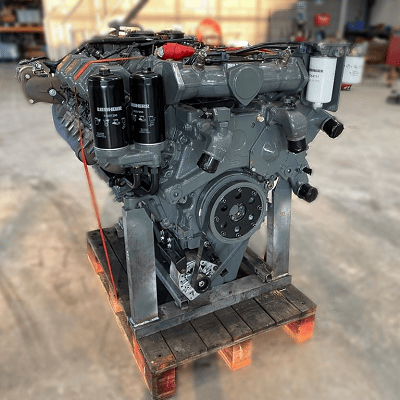The process of a dyno test on a Liebherr engine

When it comes to heavy machinery, reliability and power are paramount. Liebherr, a name synonymous with innovation and excellence in engineering, stands tall as a pioneer in the realm of heavy Equipment and machinery. From towering cranes to robust excavators, Liebherr’s engineering prowess extends to the heart of these machines. We delve into the world of dyno testing a Liebherr engine, uncovering the meticulous process behind unleashing the raw power concealed within.
The foundation of excellence
Before we embark on the journey of dyno testing, it’s crucial to understand the foundation upon which Liebherr engines are built. With decades of engineering expertise and commitment to quality, Liebherr engines are crafted to withstand the most demanding environment and deliver unparalleled performance. Each component is meticulously designed and rigorously tested to ensure reliability, efficiency and longevity.
The process
1 Preparation: The engine undergoes meticulous preparation before being mounted onto the dynamo meter. This includes ensuring all connections are secure, fluids are filled to the appropriate levels, and sensors are properly calibrated.
2 Mounting: The engine is carefully mounted onto the dynamometer, a specialized device designed to simulate real-world operating conditions. Precision is paramount during this step to ensure accurate results.
3 Initial checks: Once mounted, a series of initial checks are conducted to verify proper alignment, connection integrity, and functionality of all engine systems.
4 Warm-up: The engine is started and allowed to warm up to operating temperature. This ensures consistent results and minimizes the risk of damage during testing.
5 Baseline testing: With the engine warmed up , baseline tests are conducted to establish initial performance metrics. This includes measuring power output, torque, fuel consumption, and emissions at various RPM levels.
6 Load testing: The engine is subjected to progressively increasing loads to simulate different operating conditions, such as idle, partial load and full load. This allows engineers to assess performance across the entire operating range and identify any potential issues or optimization.
7 Data analysis: Throughout the testing process, data is continuously collected and analyzed in real-time. Advanced instrumentation and software are used to monitor performance metrics and identify trends or anomalies.
8 Optimazation: Based on the data analysis, adjustments may be made to optimize engine performance. This could involve fine-tuning fuel injection timing, adjusting air-fuel ratios, or optimize turbocharger boost pressure.
9 Validation: Once testing is complete, the results are meticulously reviewed and validated against predetermined criteria and specifications. Any deviations or anomalies are thoroughly investigated to ensure accuracy and reliability.
10 Reporting: Finally, a comprehensive report is generated detailing the results of the dyno testing, including performance metrics, observations, and any recommendations for further optimization or refinement.
The outcome of dyno testing
Dyno testing a Liebherr engine is more than just a routine procedure – it’s a testament to the unwavering commitment to excellence that defines Liebherr’s engineering philosophy. By subjecting their engines to rigorous testing and analysis, Liebherr ensures that each engine delivers the uncompromising performance, reliability, and efficiency that customers expect.
In conclusion, dyno testing a Liebherr engine is not just about measuring power output. It’s about unlocking the true potential of these remarkable engines and ensuring they exceed expectations in the most challenging environments imaginable.
Hot Melt Adhesive For Carton And Box
Hot melt adhesive is a kind of plastic adhesive, in a certain temperature range, its physical state changes with the temperature, and the chemical characteristics remain unchanged, its non-toxic and tasteless, is an environmentally friendly chemical product.
Hot melt adhesive is the use of hot melt machine through the heat to melt the hot melt adhesive, the glue after melting into a liquid, through the hot melt machine throat and spray gun, sent to the surface of the bonded material, hot melt adhesive cooling is completed the bonding, it can meet the requirements of the carton sealing, and overcome the previous carton sealing form defects.
Advantages of hot melt adhesive bonding:
1, fast, the whole bonding process only takes 1-3 seconds to complete (even faster).
2, occupy less space, hot melt adhesive body shape is small, only a small space.
3, the lowest production cost per unit of product.
4, the bonding effect is good, the bonding strength is high, and the overall strength of the carton after bonding is strengthened, so that the carton is not easy to deform and crack.
5, no waste disposal problem. Meet the requirements of environmental protection, meet the requirements of export packaging.
6, with anti-theft effect, can cite whether the packaging object has been opened without authorization.
7, can adjust different spraying methods to play a role in identification and anti-counterfeiting.
Hot Melt Adhesive For Carton And Box,Carton Sealing Hot Melt Adhesive,Carton Sealing Hot Melt Glue,Hot Melt Adhesives Machine
Shenzhen Tongde New Materials Technology Co., Ltd. , https://www.tdhotmeltglue.com